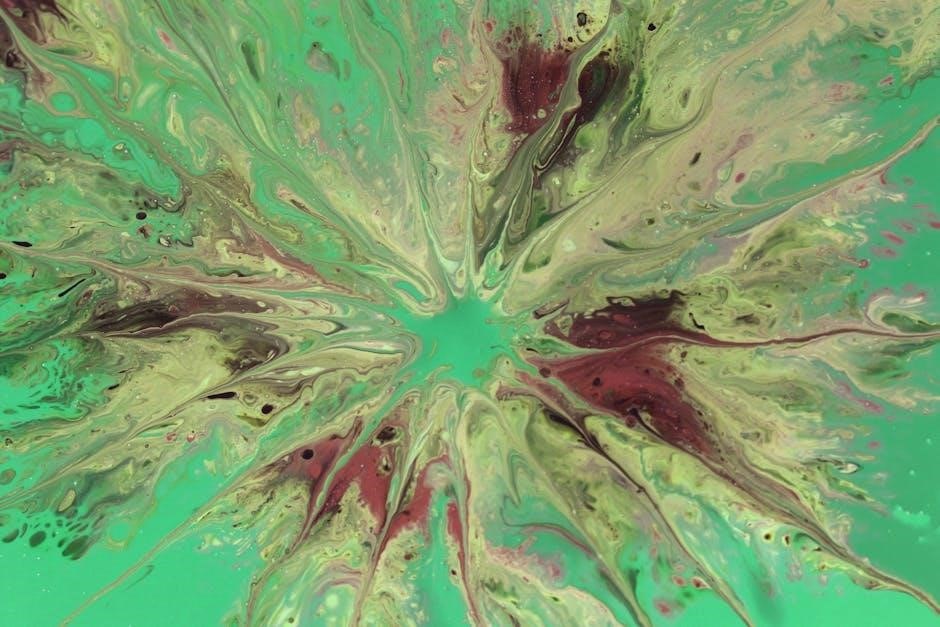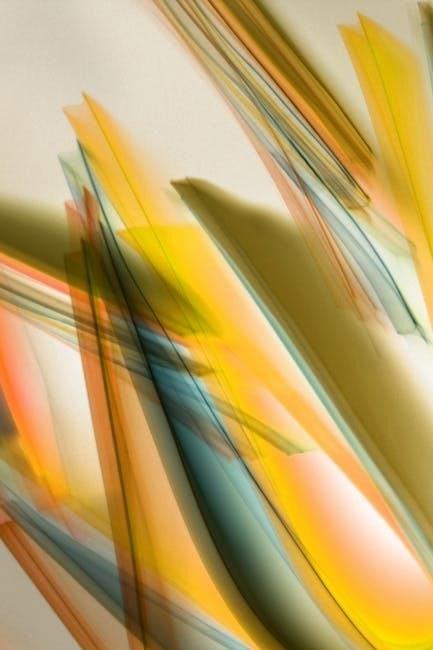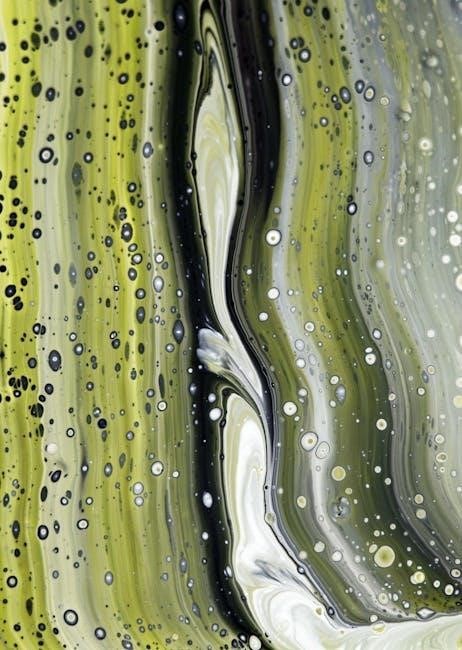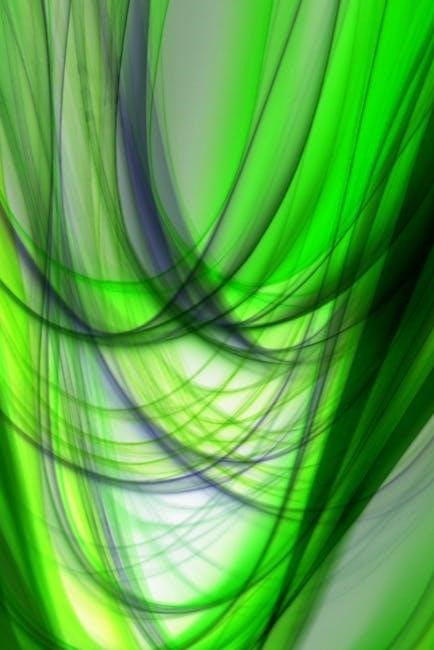Gateways to Art: Understanding the Visual Arts, Fourth Edition, by Debra J. DeWitte, Ralph M. Larmann, and M. Kathryn Shields, is a comprehensive textbook published by Thames & Hudson. It introduces students to the fundamentals of visual arts, emphasizing critical thinking, visual analysis, and a global perspective. The book features a student-centered approach, enhanced visual analysis tools, and cross-cultural references, making it an essential resource for art education.
Overview of the Book
Gateways to Art: Understanding the Visual Arts, Fourth Edition is a comprehensive textbook designed to introduce students to the fundamentals of visual arts. Authored by Debra J. DeWitte, Ralph M. Larmann, and M. Kathryn Shields, it emphasizes critical thinking, visual analysis, and a global perspective. The book features a student-centered approach, enhanced visual analysis tools, and cross-cultural references. It explores artistic principles, history, and techniques, while integrating digital resources to engage students. The text is structured to foster a deeper understanding of art across time and cultures, making it an essential resource for art education.
Authors and Publication Details
Gateways to Art: Understanding the Visual Arts, Fourth Edition is authored by Debra J. DeWitte, Ralph M. Larmann, and M. Kathryn Shields. Published by Thames & Hudson, this textbook is a trusted resource in art education. The authors bring extensive expertise in visual arts, ensuring a well-rounded and insightful exploration of artistic principles and history. Their collaborative effort has resulted in a text that is both comprehensive and accessible, making it a cornerstone for students and educators alike in understanding the visual arts.
Target Audience and Purpose
Gateways to Art: Understanding the Visual Arts, Fourth Edition is designed for undergraduate students, art enthusiasts, and educators seeking a comprehensive introduction to the visual arts. Its purpose is to foster critical thinking and visual analysis skills, while engaging readers with diverse artistic traditions and global perspectives. The text is structured to be accessible and thought-provoking, making it an ideal resource for both classroom instruction and independent study in art history and appreciation.

Key Features of the Fourth Edition
Gateways to Art, Fourth Edition offers a student-centered approach, enhanced visual analysis tools, and a global perspective with cross-cultural references. It includes digital resources and critical thinking exercises to engage learners and deepen understanding of the visual arts.
Student-Centered Approach
Gateways to Art, Fourth Edition emphasizes a student-centered approach, focusing on engaging learners through interactive and personalized experiences. The text offers critical thinking exercises, cross-cultural comparisons, and visual analysis tools that cater to diverse learning styles. Enhanced digital resources, such as online study guides and multimedia content, support both in-class and out-of-class learning. This approach fosters a deeper understanding of art by encouraging students to explore and interpret artworks independently, making the learning process more meaningful and interactive.
Enhanced Visual Analysis Tools
Gateways to Art, Fourth Edition provides enhanced visual analysis tools that help students develop a deeper understanding of artworks. These tools include guided exercises, cross-references, and comparative studies that encourage students to analyze and interpret visual elements. The text incorporates high-quality images and digital resources, enabling students to engage with artworks in a more interactive and meaningful way. This approach not only enhances critical thinking but also equips students with the skills to analyze art effectively, fostering a lifelong appreciation for visual arts.
Global Perspective and Cross-Cultural References
Gateways to Art, Fourth Edition emphasizes a global perspective, integrating non-Western art traditions, pre-Columbian art, and Asian and African influences. This approach challenges the Eurocentric canon, offering students a broader understanding of artistic diversity. Cross-cultural references encourage comparative analysis, highlighting how different traditions interact and influence one another. By exploring global artistic expressions, the text fosters cultural awareness and appreciation, preparing students to engage with the rich and varied heritage of visual arts worldwide.
Digital Resources and Supplements
Gateways to Art, Fourth Edition offers a range of digital resources to enhance learning. The online companion website provides study guides, image galleries, and interactive tools for students. Instructors benefit from a manual, test bank, and slides. Digital formats, including PDF, ePub, and MOBI, ensure accessibility. These resources engage students, support critical thinking, and accommodate diverse learning styles, making the textbook a versatile and modern educational tool for both in-class and independent study.

Structure and Organization
Gateways to Art, Fourth Edition is organized thematically, focusing on critical thinking and visual analysis. It integrates diverse artistic traditions, ensuring a cohesive and engaging learning experience.
Chapter Breakdown and Content
Gateways to Art, Fourth Edition is divided into chapters that explore artistic principles, historical movements, and global perspectives. Each chapter focuses on key themes, such as line, shape, and form, as well as color and composition. The book covers prehistoric to contemporary art, emphasizing critical thinking and visual analysis. Chapters include case studies, comparative analyses, and exercises to engage students. Digital resources and study guides complement the text, providing a comprehensive learning experience. This structure ensures a deep understanding of the visual arts.
Thematic Approach to Art History
The book adopts a thematic approach to art history, focusing on universal themes like art and identity, art and religion, and art and society. This method encourages students to explore connections across time and cultures, rather than following a strictly chronological order. By examining how different artists and cultures address common themes, students gain a deeper understanding of art’s role in reflecting and shaping human experiences. This approach fosters critical thinking and broadens perspectives on the global art historical narrative.
Integration of Critical Thinking Exercises
Gateways to Art integrates critical thinking exercises throughout its chapters, encouraging students to engage deeply with artworks and their contexts. These exercises prompt learners to analyze visual elements, interpret meanings, and draw connections between art and broader cultural or historical themes. By fostering inquiry and reflection, the book helps students develop analytical skills and think creatively about the role of art in society, preparing them to apply these insights in their own studies and beyond.

Visual Analysis and Critical Thinking
Gateways to Art emphasizes visual analysis and critical thinking, equipping students with methods to interpret artworks, fostering a deeper understanding of artistic principles and cultural contexts.
Methods for Analyzing Artworks
The fourth edition of Gateways to Art provides structured methods for analyzing artworks, including formal analysis, contextual research, and comparative studies. Students learn to examine elements like line, shape, and color, as well as the historical and cultural contexts of artworks. Enhanced visual analysis tools and cross-references encourage deeper engagement and critical thinking. Digital resources, such as image galleries and interactive exercises, further support students in developing their analytical skills and understanding of artistic principles.
Developing a Critical Eye
The fourth edition of Gateways to Art emphasizes developing a critical eye through structured analysis and comparative studies. It encourages students to move beyond surface-level observations by exploring artistic principles, historical contexts, and cultural influences. Enhanced visual tools and cross-references facilitate deeper engagement, while digital resources provide interactive exercises to refine analytical skills. This approach fosters a nuanced understanding of art, preparing students to interpret and evaluate artworks critically.
Case Studies and Comparative Analysis
The fourth edition of Gateways to Art incorporates detailed case studies and comparative analysis to deepen students’ understanding of artistic styles and cultural contexts. By examining specific artworks from diverse periods and regions, students learn to identify similarities and differences, fostering a broader appreciation of global art traditions. Comparative tools and digital resources enable side-by-side analysis, while real-world examples highlight the relevance of art in historical and contemporary societies, encouraging insightful and informed discussions.

Artistic Principles and Elements
Gateways to Art explores essential artistic elements like line, shape, form, color, and texture, providing students with a foundational understanding of visual composition and artistic expression.
Line, Shape, and Form
Gateways to Art delves into the fundamental elements of visual arts, beginning with line, shape, and form. Lines can vary in direction, thickness, and texture, creating movement and rhythm. Shapes, whether geometric or organic, define spaces and forms. Form refers to three-dimensional objects, explored through techniques like modeling and perspective. These elements are essential for understanding composition and artistic expression, guiding students to analyze and interpret artworks effectively.
Color and Composition
Gateways to Art explores the dynamic role of color and composition in visual arts. Color theory, including the color wheel and primary-secondary color relationships, is examined to understand mood, harmony, and contrast. Composition discusses how artists arrange elements like line, shape, and form to create balance, unity, and visual flow. Techniques like perspective, symmetry, and negative space are highlighted, enabling students to critically analyze and appreciate the structural and emotional impact of artworks.
Texture and Space
Gateways to Art delves into the exploration of texture and space in visual arts. Texture, both tactile and visual, adds depth and sensory engagement to artworks, while space creates a sense of atmosphere and dimension. Artists use techniques like perspective, overlapping, and composition to manipulate space, guiding the viewer’s eye. The interplay of texture and space enhances the emotional and narrative impact of art, fostering a deeper connection between the viewer and the artwork.

Art History and Movements
Gateways to Art explores the evolution of art through history, from prehistoric to contemporary movements. It examines iconic styles, cultural influences, and groundbreaking artists, tracing the development of visual expression across eras and regions. This section provides a chronological framework, connecting artistic innovations to their historical contexts, offering students a rich understanding of how art has shaped and reflected human experience over time.
Prehistoric and Ancient Art
Gateways to Art delves into the origins of human creativity, exploring prehistoric art like cave paintings at Lascaux and megalithic structures such as Stonehenge. It examines the symbolic and functional roles of early artifacts, transitioning to ancient civilizations, including Egyptian tombs, Mesopotamian reliefs, and Greek sculptures. The section highlights how these cultures expressed their beliefs, values, and achievements through art, laying the foundation for later artistic traditions and providing insights into the evolution of human expression.
Medieval to Renaissance Art
Gateways to Art explores the transition from medieval religious art to the Renaissance humanist ideals. It examines iconic works like Giotto’s frescoes and Fra Angelico’s altarpieces, highlighting the shift from flat, symbolic compositions to perspective and realism. The section also covers Northern Renaissance innovations, such as Jan van Eyck’s oil painting techniques, alongside Italian masters like Leonardo da Vinci and Michelangelo. This period’s art reflects a growing focus on individualism, classical influences, and scientific observation, bridging the spiritual and the secular in a transformative era.
Modern and Contemporary Art
Gateways to Art delves into the dynamic evolution of modern and contemporary art, highlighting movements like Impressionism, Cubism, Surrealism, and Abstract Expressionism. It explores the works of pioneers such as Picasso, Warhol, and Pollock, emphasizing their innovative techniques and conceptual frameworks. The section also addresses global contemporary practices, including digital art and installations, reflecting diverse cultural perspectives and the blurring of boundaries between art and everyday life. This chapter underscores the ongoing dialogue between tradition and experimentation in the modern era.

Cultural and Global Perspectives
The text explores diverse artistic traditions worldwide, emphasizing cross-cultural influences and non-Western art’s significance in shaping contemporary practices, fostering a global understanding of visual arts.
Non-Western Art Traditions
This section delves into the rich and diverse artistic practices from regions outside the Western canon, offering insights into their cultural, historical, and aesthetic significance. By examining traditions from Asia, Africa, and the Indigenous Americas, the text highlights the unique perspectives and contributions of these cultures to the global art landscape. It emphasizes the importance of understanding these traditions within their specific contexts, fostering a more inclusive and comprehensive appreciation of visual arts worldwide.
Pre-Columbian and Indigenous Art
Pre-Columbian and Indigenous Art explores the vibrant cultures and artistic traditions of the Americas before European contact. This section highlights the spiritual, communal, and symbolic significance of these works, often created from natural materials like stone, clay, and textiles. It emphasizes the ingenuity and creativity of Indigenous peoples in expressing their connection to the land and their cosmological beliefs.
By examining iconic pieces from regions such as Mesoamerica and the Andean world, the text underscores the enduring legacy of these art forms. Their influence continues to inspire contemporary artists, bridging ancient traditions with modern interpretations and fostering cross-cultural understanding.
Asian and African Artistic Influences
Asian and African Artistic Influences delve into the rich cultural and artistic traditions of these continents. From the intricate calligraphy of Chinese and Japanese art to the vibrant textiles of African cultures, this section highlights the unique techniques and materials that define these artistic practices. It explores how Asian philosophies, such as Zen Buddhism, influenced minimalist designs, while African art often reflects communal values and spiritual connections. These traditions continue to inspire global art, showcasing their enduring relevance and beauty.

Techniques and Media
Techniques and Media explores various artistic methods, from traditional painting and sculpture to modern printmaking and digital art. These mediums shape creative expression and artistic innovation.
Painting and Sculpture
Painting and Sculpture are foundational techniques explored in the book, highlighting their historical and cultural significance. Painting involves diverse mediums like oil, acrylic, and watercolor, while sculpture encompasses materials such as marble, bronze, and wood. Both practices emphasize artistic expression, form, and texture. The book provides insights into these mediums’ evolution, from traditional methods to contemporary innovations, offering students a deeper understanding of their role in visual arts and their continued relevance in modern artistic practices.
Printmaking and Photography
Printmaking and Photography are explored as versatile mediums that revolutionized art production. Printmaking techniques, such as lithography, etching, and screen printing, allow artists to create multiple copies, democratizing art. Photography, with its ability to capture reality, has transformed how we perceive and document the world. Both mediums emphasize technical precision and creative expression, offering unique ways to communicate ideas. The book highlights their historical development and their continued relevance in contemporary artistic practices, bridging tradition and innovation. These mediums remain essential in the modern art landscape.
Digital and New Media Art
Digital and New Media Art explores the innovative use of technology in creating contemporary artworks. From digital painting to 3D modeling, artists utilize software and digital tools to push creative boundaries. Virtual reality, interactive installations, and digital sculptures exemplify how technology transforms artistic expression. The book highlights the role of new media in expanding traditional art forms, offering insights into the techniques and cultural impacts of these emerging practices. This section bridges the gap between traditional and modern artistic methods, showcasing the endless possibilities of digital creativity.

Art in Context
Art in Context examines how artworks reflect and interact with their cultural, social, and historical environments. It explores themes like art and religion, politics, and society, revealing how art communicates ideas and emotions, serving as both a mirror of cultural values and a catalyst for change. This section emphasizes the interconnectedness of art and its surroundings, offering insights into the broader human experience.
Art and Religion
Art and Religion explores the profound connection between spiritual expression and visual arts. From sacred symbols to ritualistic practices, art has long served as a bridge between the divine and human experience. Across cultures, religious art communicates theological beliefs, moral values, and emotional devotion. Iconic works, such as Gothic cathedral stained glass or Buddhist sculptures, illustrate how art transcends language, uniting people in shared spiritual journeys. This section highlights how art reflects and shapes religious identity, offering insights into the universal quest for meaning and transcendence.
Art and Politics
Art and Politics examines how visual arts reflect and influence societal power structures, ideologies, and political movements. Throughout history, art has served as a tool for propaganda, protest, and social commentary. From murals celebrating leaders to installations critiquing inequality, art engages viewers in political discourse. This section explores iconic works that challenge authority, promote reform, and inspire collective action, demonstrating art’s role as both a mirror of and catalyst for political change. It underscores the enduring connection between creativity and activism.
Art and Society
Art and Society delves into the dynamic relationship between artistic expression and cultural context. Art reflects societal values, norms, and identity, often challenging or reinforcing them. This section explores how diverse cultures use art to communicate shared experiences, addressing themes like community, tradition, and social justice. By examining various mediums and historical periods, it highlights art’s role in shaping and mirroring societal change, fostering empathy and understanding across cultures; This connection underscores art’s power to unite and inspire collective growth.
Resources for Students and Instructors
- Online Companion Websites offer interactive tools and multimedia content.
- Instructor’s Manual and Test Bank provide lesson plans and assessment materials.
- Image Gallery includes high-resolution artwork for detailed study.
- Study Guides reinforce key concepts and promote independent learning.
Online Companion Websites
The fourth edition offers online companion websites packed with interactive tools and multimedia content. These resources engage students with quizzes, flashcards, and slides for review. Instructors benefit from customizable materials, while the image gallery provides high-resolution artworks for detailed analysis. The websites also include videos, audio resources, and links to additional readings, fostering a dynamic learning environment. Regular updates ensure content remains relevant, making these digital companions indispensable for both teaching and studying visual arts.
Instructor’s Manual and Test Bank
The Instructor’s Manual and Test Bank for the fourth edition provides educators with a comprehensive teaching package. It includes lesson plans, discussion prompts, and assessment tools to support classroom instruction. The Test Bank offers a variety of question types, such as multiple-choice and essay questions, to evaluate student understanding. These resources are designed to align with the textbook’s content, ensuring a cohesive and structured approach to teaching the visual arts. Instructors can access these materials online, making it easy to prepare engaging and effective lessons.
Image Gallery and Study Guides
The Image Gallery and Study Guides accompanying the fourth edition provide a wealth of resources for both instructors and students. The image gallery features high-quality reproductions of artworks for detailed analysis, while the study guides offer interactive exercises and summaries to reinforce key concepts. These tools are designed to enhance student engagement and understanding, making them invaluable for both in-class and independent study. The resources are accessible online, ensuring easy access for all users.

Reception and Reviews
Gateways to Art: Understanding the Visual Arts, Fourth Edition has received positive reviews for its comprehensive approach and student-centered design. It is highly recommended for art education.
Academic Reception and Reviews
Gateways to Art: Understanding the Visual Arts, Fourth Edition has been widely praised by academics for its comprehensive and inclusive approach to art education. Reviewers highlight its strong emphasis on critical thinking and visual analysis, as well as its global perspective, which sets it apart from traditional Eurocentric art histories. The textbook is commended for its accessibility and ability to engage students, making it a valuable resource for both instructors and learners in the field of visual arts.
Student Feedback and Engagement
Students have praised Gateways to Art: Understanding the Visual Arts, Fourth Edition for its engaging and accessible approach. The book’s visual analysis tools and cross-cultural references have been particularly highlighted, making complex art concepts easier to grasp. Many appreciate the global perspective, which broadens their understanding of diverse artistic traditions. The digital resources and interactive exercises also encourage active learning and critical thinking, fostering a deeper connection to the material and enhancing overall engagement with the visual arts.
Comparisons with Previous Editions
The fourth edition of Gateways to Art: Understanding the Visual Arts builds upon earlier versions with significant enhancements. It features expanded global perspectives, enhanced digital resources, and new case studies for deeper engagement. Improved visual analysis tools and updated images provide clearer insights into artistic principles. Additionally, more critical thinking exercises encourage active learning. These updates make the fourth edition more comprehensive and student-friendly compared to previous versions, offering a refreshed and enriched learning experience for visual arts education.
Accessing the Fourth Edition
Gateways to Art: Understanding the Visual Arts, Fourth Edition is available in hardcover and digital formats. Purchase options include online retailers, bookstores, and e-book platforms. Digital versions, such as PDF, can be downloaded from authorized sellers. Libraries and rental services also offer access, providing flexible options for students and educators seeking this comprehensive art education resource.
Purchasing Options and Availability
Gateways to Art: Understanding the Visual Arts, Fourth Edition is widely available for purchase through various channels. Students and educators can buy the hardcover edition from major online retailers like Amazon or directly from the publisher, Thames & Hudson. Digital versions, including PDF, can be purchased from e-book platforms such as Amazon Kindle or academic databases. Additionally, the textbook is available for rent or borrowing through library services, offering flexibility for those seeking temporary access to this essential art education resource.
Digital Formats and PDF Availability
Gateways to Art: Understanding the Visual Arts, Fourth Edition is available in digital formats, including PDF, for convenient access. The PDF version can be purchased through platforms like Amazon Kindle, Google Play Books, and the publisher’s website. Additionally, some academic databases and e-bookstores offer the PDF for download. Students and educators can also explore free PDF downloads from trusted sources, ensuring easy access to this comprehensive art education resource. Always verify the source for authenticity and quality.
Library and Rental Options
Gateways to Art: Understanding the Visual Arts, Fourth Edition is widely available in libraries and through rental services, offering affordable access for students. Many academic libraries carry copies of the textbook, and digital versions can be accessed through library databases. Additionally, platforms like Amazon Rental and textbook rental websites provide options to rent the book for a specific period. This flexibility ensures students can access the material without purchasing, making it a cost-effective choice for those needing temporary use.


